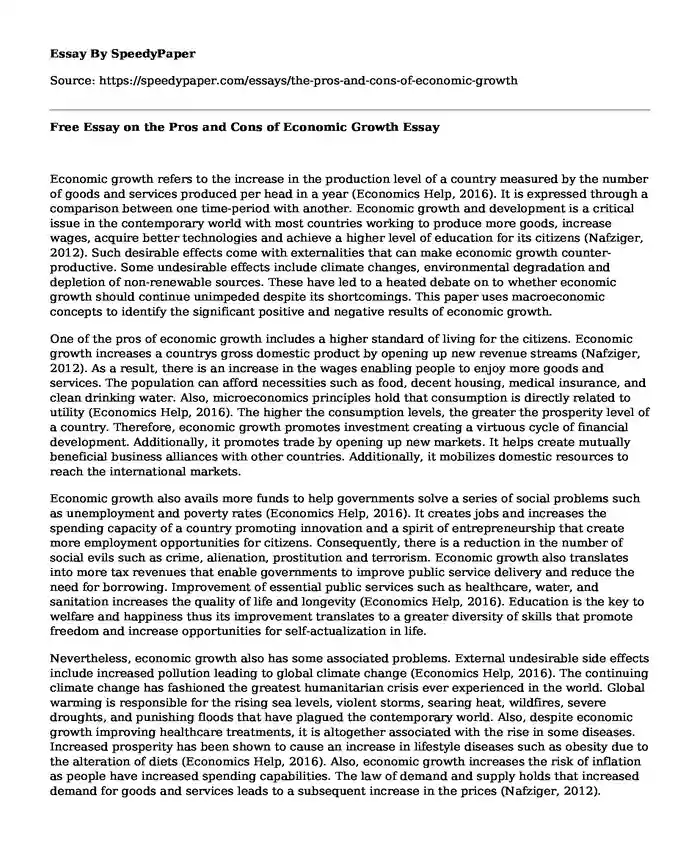Economic growth refers to the increase in the production level of a country measured by the number of goods and services produced per head in a year (Economics Help, 2016). It is expressed through a comparison between one time-period with another. Economic growth and development is a critical issue in the contemporary world with most countries working to produce more goods, increase wages, acquire better technologies and achieve a higher level of education for its citizens (Nafziger, 2012). Such desirable effects come with externalities that can make economic growth counter-productive. Some undesirable effects include climate changes, environmental degradation and depletion of non-renewable sources. These have led to a heated debate on to whether economic growth should continue unimpeded despite its shortcomings. This paper uses macroeconomic concepts to identify the significant positive and negative results of economic growth.
One of the pros of economic growth includes a higher standard of living for the citizens. Economic growth increases a countrys gross domestic product by opening up new revenue streams (Nafziger, 2012). As a result, there is an increase in the wages enabling people to enjoy more goods and services. The population can afford necessities such as food, decent housing, medical insurance, and clean drinking water. Also, microeconomics principles hold that consumption is directly related to utility (Economics Help, 2016). The higher the consumption levels, the greater the prosperity level of a country. Therefore, economic growth promotes investment creating a virtuous cycle of financial development. Additionally, it promotes trade by opening up new markets. It helps create mutually beneficial business alliances with other countries. Additionally, it mobilizes domestic resources to reach the international markets.
Economic growth also avails more funds to help governments solve a series of social problems such as unemployment and poverty rates (Economics Help, 2016). It creates jobs and increases the spending capacity of a country promoting innovation and a spirit of entrepreneurship that create more employment opportunities for citizens. Consequently, there is a reduction in the number of social evils such as crime, alienation, prostitution and terrorism. Economic growth also translates into more tax revenues that enable governments to improve public service delivery and reduce the need for borrowing. Improvement of essential public services such as healthcare, water, and sanitation increases the quality of life and longevity (Economics Help, 2016). Education is the key to welfare and happiness thus its improvement translates to a greater diversity of skills that promote freedom and increase opportunities for self-actualization in life.
Nevertheless, economic growth also has some associated problems. External undesirable side effects include increased pollution leading to global climate change (Economics Help, 2016). The continuing climate change has fashioned the greatest humanitarian crisis ever experienced in the world. Global warming is responsible for the rising sea levels, violent storms, searing heat, wildfires, severe droughts, and punishing floods that have plagued the contemporary world. Also, despite economic growth improving healthcare treatments, it is altogether associated with the rise in some diseases. Increased prosperity has been shown to cause an increase in lifestyle diseases such as obesity due to the alteration of diets (Economics Help, 2016). Also, economic growth increases the risk of inflation as people have increased spending capabilities. The law of demand and supply holds that increased demand for goods and services leads to a subsequent increase in the prices (Nafziger, 2012). Therefore, greater availability of money among consumers leads to a resultant increase in the prices of goods and services by firms.
In conclusion, economic growth clearly has several advantages and disadvantages. The benefits include the enabling the government to deal with many serious societal problems, provide essential amenities, improve the standards of living and promote investments. However, economic growth has also contributed to climate change, increased inflation, and the emergence of new diseases. Therefore, governments have an obligation to harness the potential benefits of economic growth to make sure it improves the quality of life of all the people at the least cost. It should also purpose to prevent and offer solutions to the adverse effects of economic growth, for example, through the use of greener technologies to promote growth as well as prevent environmental pollution. These will ensure that economic growth is balanced and sustainable thus improving the overall quality of life of all the people.
References
Economics Help, (2016). Benefits of economic growth |Economicshelp.org. Retrieved 16 September 2016, from http://www.economicshelp.org/macroeconomics/economic-growth/benefits-growth/
Economics Help, (2016). Costs of economic growth |Economicshelp.org. Retrieved 16 September 2016, from http://www.economicshelp.org/macroeconomics/economic-growth/costs/
Nafziger, E. (2012). Economic development. Cambridge New York: Cambridge University Press.
Cite this page
Free Essay on the Pros and Cons of Economic Growth. (2019, Oct 31). Retrieved from https://speedypaper.com/essays/the-pros-and-cons-of-economic-growth
Request Removal
If you are the original author of this essay and no longer wish to have it published on the SpeedyPaper website, please click below to request its removal:
- Vast Difference, Free Essay on Stereotypes
- Banning Bottled Water in Canada - Free Essay on Environmental Problems
- The Legacy of the Elephant Man - Movie Review Essay Example
- Free Essay on Police Response to Domestic Violence
- History of L Brands Inc., Free Essay in Management
- Topic of the Essay Sample: Patient Education on Diabetes Management
- Teamwork and Decision-Making - Reflective Journal Paper Example
Popular categories





